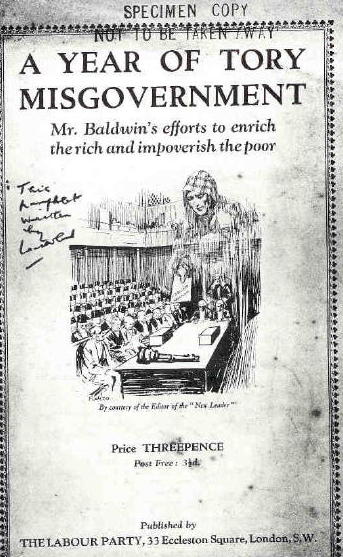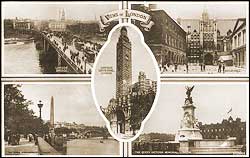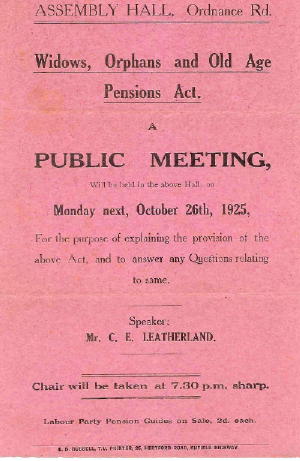LABOUR PARTY PRESS & PUBLICITY DEPT
In 1924 Charles moved to London with his wife Mollie and one year old daughter, Irene. He had a new job as Parliamentary Correspondent in the Labour Party's Press and Publicity Department based in Ecclestone Square, Victoria. The building in Ecclestone Square used to be the home of Winston Churchill and his family.
He worked there for five years becoming the second in command to the Party's press officer, Will Henderson, whose father was leader of the Labour Party for several years.
His job included writing Labour Party pamphlets and leaflets, drafting speaker's notes for Labour MPs, and reporting the proceedings of Parliament as a lobby correspondent in the House of Commons. His Parliamentary reports were syndicated to local and regional newspapers all over the country as the Labour Press Service.

THE BOOK OF THE LABOUR PARTY
In 1925 he wrote eleven chapters of "The Book of the Labour Party", a three volume guide to the history of the Party, its policies and its personalities. This book was the first major history of the Labour Party and the Labour movement. He was paid £75 and 12 shillings by the publishers for his contributions.

In 1925 he moved from Clapham Common to Hooking Green in Harrow, Middlesex.
1917 CLUB
Leatherland became a member of the 1917 Club, a socialist meeting society which met in Gerrard Street, Soho. The 1917 Club became one of the haunts of the Bloomsbury Group. Its members included Ramsay MacDonald (later Prime Minister), Leonard Woolf (husband of Virginia Woolf), and C.E.M. Joad - a left wing philosopher who later became famous as a panellist on the Brains Trust, a BBC radio discussion programme.

SHORTHAND REPORTER
Leatherland was a talented verbatim shorthand reporter (an essential talent for a journalist in those days). He was awarded a certificate showing he could write 120 words per minute at the age of 16. In the 1920s he took shorthand notes at several public enquiries, including a 200,000 word record of the Board of Trade enquiry into the silk industry.
In Christopher Andrew's history of MI5 “The Defence of the Realm : The Authorised History of MI5”, Professor Andrew explains that the Conservative Party had a spy inside Labour Party headquarters in the later 1920s. He quotes Conservative Party Chairman J.C.C. Davidson (later Viscount Davidson) who admitted in his “Memoirs of a Conservative” (1969) that, in 1927, he recruited a Major Joseph Ball 'to help run a little intelligence service of our own' distinct from Conservative Party Central Office. Ball was a former Scotland Yard police officer – and a barrister - who joined MI5 in 1915 but left the service in 1926.
Davidson said : “We had agents in certain key centres and we also had agents actually in the Labour Party Headquarters, with the result that we got their reports on political feeling in the country, as well as our own. We also got advance “pulls” of their literature. This we arranged with Odhams Press, who did most of the Labour Party printing , with the result that we frequently received copies of their leaflets and publications before they reached Transport House. This was of enormous value to us because we were able to study the Labour Party policy in advance, and in the case of leaflets we could produce a reply to appear simultaneously with their production.”
Three years later in 1930 Joseph Ball was appointed as the first director of the new Conservative Party Research Department.
Leatherland played a significant behind the scenes role in the General Strike. The Labour Party Press Department also acted as the Trade Union Congress Press Office, sharing the same building in Ecclestone Square.
During the General Strike in 1926, Leatherland wrote much of the contents of The British Worker, the TUC's strike newspaper, including the TUC's famous "Message to All Workers" which appeared on the front cover of every issue. He also wrote the TUC General Council's reply to the Prime Minister's message to the nation.
